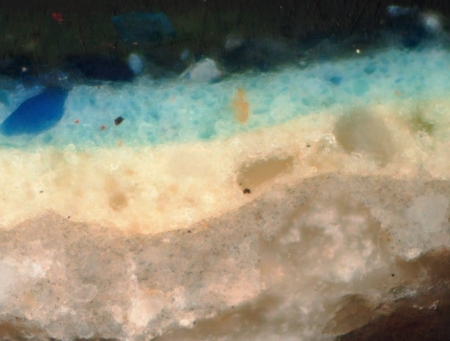Many colorants, including the blue pigments ultramarine and azurite, were imported, often in a raw or partially processed state, and then refined in Venice. Others were manufactured in the city from imported raw materials: vermilion, for example was created by heating mercury and sulfur, while glass-based colorants were produced in many hues for enameling, painting on glass, and ceramic glazing and as pigments for painters. In Renaissance Venice all these colorant materials were sold by specialist color sellers, and these shops form a nexus of our study. We maintain that they played a significant role in the city’s reputation as a center for color. We also hypothesize that they were more than places for the purchase of materials, serving also as locations in which knowledge about materials, both technological and aesthetic, would have been shared across the boundaries of many crafts. We ask whether the traditional secrets of craft knowledge were eroded even as artisan trades became more specialized (the color sellers were themselves specialists who emerged from the traditional profession of apothecary). We also investigate whether ways of understanding materials were altered in the face of increasing demand for luxury goods; the professionalization of artisan knowledge and vocation; the evolution of a new, scientific approach to observing and working with materials emerging out of traditional craft practice and alchemy; and changing trajectories of commerce and manufacture, including the more rapid dissemination of craft knowledge. Were the nature and behavior of materials more closely observed in the sixteenth century than previously? Were they understood in different ways?
This project was first defined a decade ago when Dr. Berrie and I embarked on a Samuel H. Kress Paired Fellowship for Research in Conservation and the History of Art at CASVA. We began with a study of the inventory of a Venetian color seller’s shop dated 1534 and its relationship to Dr. Berrie’s analytical investigations of pigments found in sixteenth-century Venetian paintings. We have pursued a number of trajectories from this initial project over the ensuing years, with publications that have culminated in this book-length study. The two-month stay at CASVA allowed me to spend significant amounts of time conferring directly with Dr. Berrie while finalizing the structure of the chapters and starting to write. The variety of fields represented by this interdisciplinary project required a wealth of library resources. The availability of these in Washington, from the National Gallery itself to the Library of Congress, and at the History of Medicine Division, National Library of Medicine, National Institutes of Health, enabled us to complete virtually all our research on the six materials.
Members' Research Report Archive
Colors and Colorants in Renaissance Venice
Louisa C. Matthew, Union College, Schenectady
Ailsa Mellon Bruce Visiting Senior Fellow, January 1–February 29, 2012
My book project, provisionally titled “A History of Colorants in Renaissance Venice,” is a collaborative undertaking with Barbara Berrie, chemist and senior conservation scientist at the National Gallery of Art. We are examining six colorant materials

Giovanni Bellini and Titian, The Feast of the Gods, 1514/1529, National Gallery of Art, Washington, Widener Collection,
- Bellini, Giovanni
- Italian, 1430 - 1516
- Titian
- Italian, 1490 - 1576
- Giovanni Bellini and Titian
- The Feast of the Gods
- 1514/1529